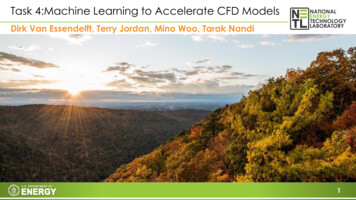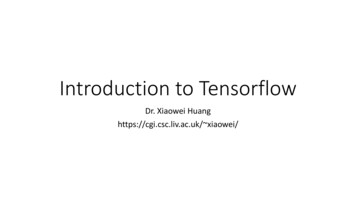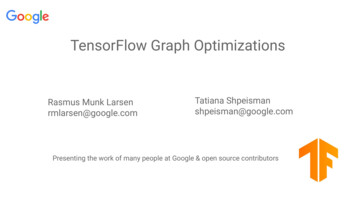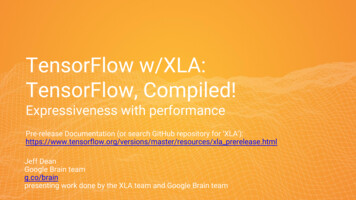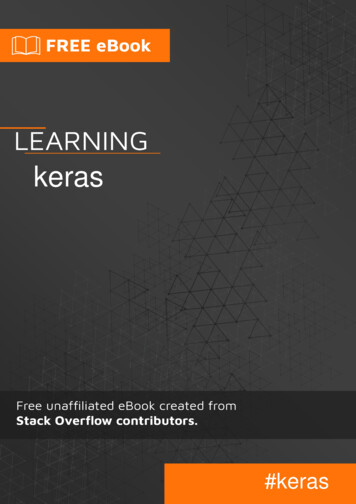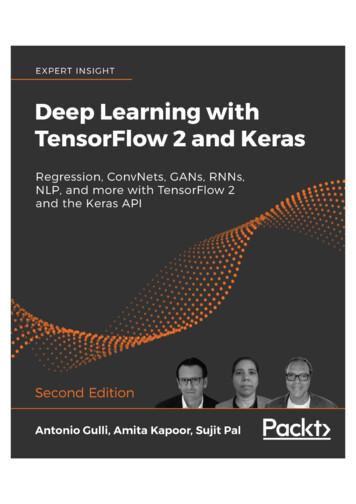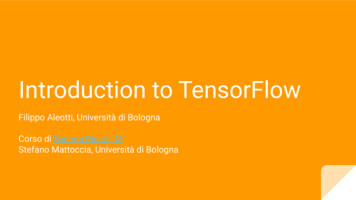
Transcription
Introduction to TensorFlowAlejandro Solano - EuroPython 2017
cat
inputtarget?cat
inputtargetsin xlogexpcat
inputtargetsin xlogexpcat
Deep Learning
What is TensorFlow? TensorFlow is an open-source library for Deep Learning. Developed by the Google Brain team and released inNovember 2015. Version 1.0.0 was launched in February 2017.
Installation
Install TensorFlow (Linux and Mac OS) Download Anaconda Create an environment with all must-have libraries. conda create -n tensorflow python 3.5 source activate tensorflow conda install pandas matplotlib jupyter notebook scipy scikit pip install tensorflow
Install TensorFlow (Windows) Download Anaconda Create an environment with all must-have libraries. conda create -n tensorflow python 3.5 activate tensorflow conda install pandas matplotlib jupyter notebook scipy scikit pip install tensorflow
Concepts
cat
MODELcat
MODELnon-cat
predictionMODELnon-cattargetinputcat
MODELnon-catCOSTcat
MODELnon-caterrorCOSTcat
MODELOPTIMIZERnon-caterrorCOSTcat
non-catMODELOPTIMIZERerrorGraphCOSTcat
GraphMODELOPTIMIZERCOST
GraphMODELplaceholderOPTIMIZERCOSTplaceholder
Graph Placeholders: gates where we introduce example Model: makes predictions. Set of variables and operations Cost function: function that computes the model error Optimizer: algorithm that optimizes the variables so the costwould be zero
Session: Graph DatainputsMODELOPTIMIZERCOSTtargets
Graph, Data and Session Graph: Layout of the prediction and learning process. It doesnot include data. Data: examples that will train the neural network. It consistson two kinds: inputs and targets. Session: where everything takes places. Here is where we feedthe graph with data.
Session: Graph DataMODELOPTIMIZERCOSTcat
Session: Graph DataMODELnon-catOPTIMIZERCOSTcat
Session: Graph DataMODELnon-catC100 OOPTIMIZERSTcat
Session: Graph DataMODELtrainnon-catC100 OOPTIMIZERSTcat
Session: Graph DataMODELOPTIMIZERcat0COSTcat
Hello world!
Hello world!: Sum of two integersimport tensorflow as tf
Hello world!: Sum of two integers
Hello world!: Sum of two integers##### GRAPH #####a tf.placeholder(tf.int32)b tf.placeholder(tf.int32)sum graph tf.add(a, b)##### DATA #####num1 3num2 8
Hello world!: Sum of two integers##### SESSION #####with tf.Session() as sess:sum outcome sess.run(sum graph, feed dict {a: num1,b: num2})
Regression
TensorFlow for Regression: learning how to sum Mission: learn how to sum using 10,000 examples.x1 x2 y
TensorFlow for Regression: learning how to sum Mission: learn how to sum using 10,000 examples.x1 ? x2 y
TensorFlow for Regression: learning how to sum Mission: learn how to sum using 10,000 examples.x1 ? x2 y729813642156157
TensorFlow for Regression: learning how to sum Mission: learn how to sum using 10,000 examples.x1 ? x2 y250 m
TensorFlow for Regression: learning how to sum Mission: learn how to sum using 10,000 examples.x1 ? x2 y729813642156157
TensorFlow for Regression: learning how to sum Mission: learn how to sum using 10,000 examples.x1 ? x2 y We assume the relationship between x and y is a linearfunction.x·W b y
TensorFlow for Regression: learning how to sum Mission: learn how to sum using 10,000 examples.x1 ? x2 y We assume the relationship between x and y is a linearfunction.x·W b yvariables to be learned
Neural Networkx·W1 b1 yx1
Neural Networkx·W1 b1 y(x·W1 b1)·W2 b2 yx12
Neural Networkx·W1 b1 y(x·W1 b1)·W2 b2 y((x·W1 b1)·W2 b2)·W3 b3 yx123
Neural Networkx·W1 b1 yσ(x·W1 b1)·W2 b2 ytanh(σ(x·W1 b1)·W2 b2)·W3 b3 yx123
TensorFlow for Regression: learning how to sum# PLACEHOLDERSx tf.placeholder(tf.float32, [None, 2])y tf.placeholder(tf.float32, [None, 1])
TensorFlow for Regression: learning how to sum# PLACEHOLDERSx tf.placeholder(tf.float32, [None, 2])y tf.placeholder(tf.float32, [None, 1])(we don’t know how manyexamples we’ll have, butwe do know that each oneof them has 2 numbers asinput and 1 as target)
TensorFlow for Regression: learning how to sum# MODELW tf.Variable(tf.truncated normal([2, 1], stddev 0.05))b tf.Variable(tf.random normal([1]))output tf.add(tf.matmul(x, W), b)
TensorFlow for Regression: learning how to sumMODELOOPTIMIZERCOST
Cost (loss) functionx·W b ypredictiontarget
Cost (loss) functiony - ( x·W b )
Cost (loss) function[ y - ( x·W b ) ]²
Cost (loss) functionΣ[ yi - ( xi·W b ) ]²
TensorFlow for Regression: learning how to sumcost tf.reduce sum(tf.square(output - y))
Gradient Descentcost functioncost f(w1, w2, b)
Gradient Descentcost functioncost f(w1, w2, b)
Gradient Descentcost functioncost f(w1, w2, b)
Gradient Descentcost functioncost f(w1, w2, b)
TensorFlow for Regression: learning how to sumoptimizer tf.train.GradientDescentOptimizer(learning rate 0.00001)optimizer optimizer.minimize(cost)
TensorFlow for Regression: learning how to sumMODELOOPTIMIZERCOST
Data splitdata
Data splitdatatrain datatest data
TensorFlow for Regression: learning how to sumfrom helper import get data, split data# DATAinputs, targets get data(max int 10, size 10000)# split train and test datatrain inputs, test inputs, train targets, test targets split data(inputs, targets)
TensorFlow for Regression: learning how to sumtraininputsMODELOOPTIMIZERCOSTtraintargets
TensorFlow for Regression: learning how to sumwith tf.Session() as sess:sess.run(tf.global variables initializer())for epoch in range(epochs):sess.run(optimizer, feed dict {x: train inputs,y: train targets})
Classification
catnon-cat
[0, 1][1, 0]
[ 0.175,MODEL0.825 ]
[ 0.457,MODEL0.543 ]
[ 0.457,MODEL0.543 ]
TensorFlow for Classification Mission: learn if the sum of two numbers is higher than 10.if ( x1 x2 10 ) then y [0; 1]else y [1; 0]
TensorFlow for Classification Mission: learn if the sum of two numbers is higher than 10.x1 ? x2 y
TensorFlow for Classification Mission: learn if the sum of two numbers is higher than 10x1 ? x2 y More complexity: we add a new layerxHOpred
Neural Networks: intuitionFirst layers extract the more basic features, while the next oneswill work from this information.xcomputesthe sumHOpredclassifiesthe sum
Neural Networks: intuitionFirst layers extract the more basic features, while the next oneswill work from this information.xHO spred(softmax)output inprobabilities
MODELHOOPTIMIZERCOST
To know more.Deep learning Neural Networks and Deep Learning - Michael NielsenStanford’s CS231n - Andrej KarpathyTensorflow Tensorflow Tutorials - Hvass LaboratoriesDeep Learning Foundations Nanodegree - Udacity
To start to know more.Basics Intro to Data Science - UdacityIntro to Machine Learning - Udacity
alesolano/mastering tensorflow
A.I.
TensorFlow is an open-source library for Deep Learning. Developed by the Google Brain team and released in November 2015. Version 1.0.0 was launched in February 2017. Installation. Install T

